2001 Pacific hurricane season
The 2001 Pacific hurricane season was a relatively near-average Pacific hurricane season which produced sixteen named storms, though most were rather weak and short-lived including one unnamed tropical storm which was operationally recognized as a tropical depression, the first such occurrence since 1996. Only eight hurricanes formed and two major hurricanes. The season officially began on May 15 in the East Pacific Ocean, and on June 1 in the Central Pacific; they ended on November 30. These dates conventionally delimit the period of each year when most tropical cyclones form in the Pacific basin. However, the formation of tropical cyclones is possible at any time of the year.
| 2001 Pacific hurricane season | |
|---|---|
 Season summary map | |
| Seasonal boundaries | |
| First system formed | May 25, 2001 |
| Last system dissipated | November 3, 2001 |
| Strongest storm | |
| Name | Juliette |
| • Maximum winds | 145 mph (230 km/h) (1-minute sustained) |
| • Lowest pressure | 923 mbar (hPa; 27.26 inHg) |
| Seasonal statistics | |
| Total depressions | 19 |
| Total storms | 16 |
| Hurricanes | 8 |
| Major hurricanes (Cat. 3+) | 2 |
| Total fatalities | 13 total |
| Total damage | $401 million (2001 USD) |
| Related articles | |
The first storm of the season, Hurricane Adolph, formed on May 25 which became the strongest hurricane in the month of May at the time. Tropical Storm Barbara passed just north of Hawaii, bringing minimal impact. The most notable storm that year was Hurricane Juliette, which caused devastating floods in Baja California Peninsula. September was much more active with six systems developing, of which three became hurricanes. Activity decreased appreciably in October and November as most of the storms remained weak and short-lived. The final storm of the season, Hurricane Octave, dissipated on November 3, about twenty-seven days before the official end of the season. Overall, this season was drastically less active and destructive, causing about $401 million in damages and thirteen fatalities.
Seasonal summary


The season officially began on May 15 in Eastern Pacific and on June 1 in Central Pacific; both ended on November 30.[1] There were sixteen tropical storms in the eastern Pacific basin during the 2001 season. Of those, seven became hurricanes, of which two became major hurricanes by reaching Category 3 intensity or higher on the Saffir–Simpson hurricane wind scale (SSHS). Four tropical depressions formed and dissipated before reaching the intensity of a named storm. In the eastern Pacific proper, the season saw average activity in terms of the number of named systems, but the season also featured seven hurricanes and two major hurricanes, both totals a bit below long term averages.[2] Overall, activity during the season was near normal.[3] The first storm of the season, Hurricane Adolph, formed in late May, slightly ahead of schedule, and at the time was the strongest May hurricane on record.[2] This season featured only one named storm in the month of June,[4] followed by three in July[5] and only one during August, including none during the first three weeks of August,[6] a time that usually sees several storms.[7] Activity picked up during the second half of the season, starting in September, when five named storms were observed, before decreasing to three and no storms in October and November respectively.[2]
On average, two to three tropical storms or hurricanes hit Mexico every year on the Pacific side. However, only one tropical cyclone, Hurricane Juliette, made landfall along the coast of Mexico in 2001. In addition, Adolph, Dalila, Ivo, and Lorena came close enough to land to require tropical cyclone warnings and watches.[2]
Systems
Hurricane Adolph
| Category 4 hurricane (SSHWS) | |
 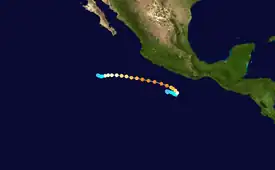 | |
| Duration | May 25 – June 1 |
|---|---|
| Peak intensity | 145 mph (230 km/h) (1-min); 940 mbar (hPa) |
Hurricane Adolph originated from a tropical wave that left Africa on May 7, and was poorly organized. It was not until May 18 that the storm showed some signs of development in the Atlantic Ocean. On, May 22 the wave crossed over, and on May 25 it intensified into Tropical Depression One-E, about 250 mi (400 km) south-southwest of Acapulco, Mexico. The system, after drifting a while, intensified into Tropical Storm Adolph the next day. Later, on May 27 Adolph was upgraded to a hurricane. Intensifying into a hurricane, Adolph rapidly intensified, and reached to Category 4 strength on May 28. Two days after, Adolph went under an eyewall replacement cycle, and weakened to a 115 mph (185 km/h) hurricane, which is minimal category 3 intensity. This trend of weakening continued, and deteriorated into a tropical storm. Passing over cooler waters, and stable air, Adolph dissipated on June 1.[8]
Tropical Storm Barbara
| Tropical storm (SSHWS) | |
  | |
| Duration | June 20 – June 26 |
|---|---|
| Peak intensity | 60 mph (95 km/h) (1-min); 997 mbar (hPa) |
A tropical wave that moved off the coast of Africa on June 1. The wave eventually entered the Pacific Ocean on June 10, though no further organization occurred until June 18.[9] The system slowly organized further over the next two days, and became Tropical Depression Two-E early on June 20.[10] Although the depression remained poorly organized, it was upgraded to Tropical Storm Barbara.[11] At 12:00 UTC on June 21, the storm attained its peak intensity with maximum sustained winds of 60 mph (97 km/h) and a minimum barometric pressure of 997 mbar (29.4 inHg). Shortly thereafter, Barbara began encountering unfavorable conditions, such higher wind shear and cooler sea surface temperatures.[12]
It weakened to a tropical depression at 18:00 UTC on June 26, while crossing 140°W into the Central Pacific Hurricane Center's area of responsibility. The depression passed north of the Hawaiian Islands on June 25, then weakened to an easterly wave to the northwest of Kauai on June 26. The remnants of Barbara continued west-northwest until being absorbed by a frontal zone near the International Date Line on June 30.[9] Barbara was the first tropical cyclone in the Central Pacific during the month of June, the second being Tropical Storm Boris in 2020.[13]
Tropical Storm Cosme
| Tropical storm (SSHWS) | |
  | |
| Duration | July 13 – July 15 |
|---|---|
| Peak intensity | 45 mph (75 km/h) (1-min); 1000 mbar (hPa) |
A tropical wave crossed Central America and emerged into the eastern Pacific basin on July 6. The wave moved slowly westward from July 6 – July 10. On July 10, the convective pattern began to show signs of organization about 403 mi (649 km) south of Acapulco, Mexico, and the system received its first Dvorak satellite classification. Over the next two days, the system moved generally west-northwestward as multiple competing low-level circulations developed within the broad area of low pressure associated with it. During this period, development of the disturbance was hindered by southerly shear from an upper-level trough to the west of the disturbance that caused the system to become elongated north–south. On July 12, the upper trough cut off southwest of the disturbance and the organization improved. By early on July 13, a single low-level circulation center had become established and Tropical Depression Three-E formed about 330 mi (530 km) southwest of Manzanillo, Mexico.[14]
The depression moved west-northwestward, and quickly became Tropical Storm Cosme on July 13, about 425 mi (684 km) south of Cabo San Lucas, Mexico. The forward motion then slowed over the next 12 hours. Cosme's development was hindered by easterly shear; its peak intensity of 45 mph (72 km/h) was reached late on July 13. By early on July 14, convection was limited and well removed from the center. Cosme weakened back to a tropical depression, when it was about 400 mi (640 km) southwest of Cabo San Lucas. Cosme produced no more significant convection after about on July 15, at which point the tropical cyclone became a non-convective low center. The low then moved slowly westward until it dissipated on July 18 about 820 mi (1,320 km) west-southwest of Cabo San Lucas.[14]
Tropical Storm Erick
| Tropical storm (SSHWS) | |
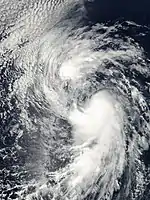  | |
| Duration | July 20 – July 24 |
|---|---|
| Peak intensity | 40 mph (65 km/h) (1-min); 1001 mbar (hPa) |
A poorly defined tropical wave traveled westward across the tropical Atlantic and reached the eastern North Pacific on July 16. The thunderstorm activity associated with the wave increased on July 18 when the disturbance was centered about 808 mi (1,300 km) south of the southern tip of the Baja California Peninsula. Thereafter, deep convection gradually developed around a large cyclonic gyre which accompanied the wave.[15] It was not until July 20 that a well-defined center of circulation formed and satellite intensity estimates supported tropical depression status. Moving on a general west-northwest track, the system became Tropical Storm Erick and simultaneously attained peak intensity with maximum sustained winds of 40 mph (64 km/h) and a minimum pressure of 1001 mbar (hPa; 29.56 inHg) July 22. It then moved over relatively cooler waters and weakened as the deep convection quickly vanished. By July 24, it was just a non-convective and dissipating swirl of low clouds, although some showers re-developed intermittently.[15]
Hurricane Dalila
| Category 1 hurricane (SSHWS) | |
  | |
| Duration | July 21 – July 28 |
|---|---|
| Peak intensity | 75 mph (120 km/h) (1-min); 987 mbar (hPa) |
Dalila's origin is a tropical wave that moved westward from Africa and over the eastern tropical Atlantic Ocean on July 10. It crossed northern South America and Central America on the July 15 through July 17 accompanied by vigorous thunderstorm activity, and then entered the Pacific basin on July 18 as an organized area of disturbed weather. Early on July 21, the system acquired a low-level circulation and became Tropical Depression Five-E, about 250 mi (400 km) south of the Gulf of Tehuantepec. Moving west-northwestward, it became Tropical Storm Dalila with 40 mph (64 km/h) winds 12 hours later.[16] Dalila steadily tracked toward the west-northwest at forward speeds fluctuating between five and 17 mph (27 km/h). The center of the cyclone reached its point of closest approach to the coast to the west coast of Mexico between Acapulco and Manzanillo on July 22 and July 23, when it came within about 100 mi (160 km) of the coast.[16] With warm sea surface temperatures and minimal vertical shear, Dalila's winds increased from 40 to 70 mph (64 to 113 km/h) from the 22nd into the 23rd. The wind speed briefly reached an estimated 75 mph (121 km/h) on July 24, and Dalila became a hurricane. However, the system quickly weakened back to a strong tropical storm. Passing directly over Socorro Island on July 25, most of the associated deep convection with Dalila dissipated on July 27 as the storm moved over colder water. Reduced to a swirl of low clouds, Dalila dissipated as a tropical cyclone on July 28, while located about 650 mi (1,050 km) west of the southern tip of Baja California.[16]
Tropical Depression Six-E
| Tropical depression (SSHWS) | |
  | |
| Duration | August 22 – August 24 |
|---|---|
| Peak intensity | 35 mph (55 km/h) (1-min); 1007 mbar (hPa) |
A westward moving tropical wave entered the Pacific from August 12 to 13 after crossing from the Atlantic and Caribbean. At 12:00 UTC on August 22, Tropical Depression Six-E developed from this wave.[17][18] In addition to lowering sea surface temperatures, the system began to be affected by southerly wind shear, which displaced the mid-level circulation and deep convection from the low-level circulation.[19][20] The National Hurricane Center later noted the disorganized state of the tropical depression as being only "... a swirl of low clouds with a few showers to the north and northeast of the center".[21] It became elongated,[22] and dissipated at 06:00 UTC on August 24.[17]
Hurricane Flossie
| Category 2 hurricane (SSHWS) | |
  | |
| Duration | August 26 – September 2 |
|---|---|
| Peak intensity | 105 mph (165 km/h) (1-min); 972 mbar (hPa) |
A tropical wave emerged into the Atlantic Ocean on August 11 and spawned Atlantic Tropical Storm Chantal three days later. After tracking westward toward the Yucatán Peninsula, the southern portion of the tropical wave split. The southern part crossed Central American and entered the Pacific Ocean on August 21. The system initially struggled to organize; however, a closed circulation developed on August 23. The low-level circulation began to become well-defined as it moved away from Mexico on August 26, while convection consolidated near the center. Later that day, it was classified as Tropical Depression Seven-E.[23] Under conditions very favorable for development,[24] and after banding features increased, the system was upgraded to Tropical Storm Flossie later on August 26.[25] While steering currents weakened,[23] Flossie began to develop a cloud-filled eye on August 27, and was upgraded to a hurricane based on that and wind estimates of 75 mph (121 km/h).[26] By early on August 29, further intensification was not expected,[27] but Flossie suddenly deepened to a Category 2 hurricane.[28] After peaking with winds of 105 mph (169 km/h) and a minimum barometric pressure of 972 mbar (28.7 inHg),[23] Flossie entered a region with sea surface temperatures less than 26 °C (79 °F).[29] Flossie weakened quickly, and weakened to a minimal hurricane 24 hours after peak intensity;[23] the National Hurricane Center noted an ill-defined eye at the time.[30] Early on August 30, Flossie weakened to a tropical storm.[31] On September 1, Flossie was downgraded to a tropical depression,[32] and after becoming devoid of deep convection,[33] the system degenerated into a remnant low on September 2.[34] The remnants of Flossie moved inland over Baja California, eventually entering the southwestern region of the United States and dissipating.
Flossie's remnants caused flash flooding in San Diego and Riverside counties in California, dropping 2 inches (51 mm) of rain in one hour. A strong downdraft knocked a tree onto a house. In addition, four people were struck by lightning, two of them fatally. The total cost of damage caused by Flossie's remnants was $35,000 (2001 USD).[23]
Hurricane Gil
| Category 2 hurricane (SSHWS) | |
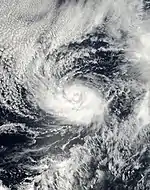  | |
| Duration | September 4 – September 10 |
|---|---|
| Peak intensity | 100 mph (155 km/h) (1-min); 975 mbar (hPa) |
A tropical wave emerged into the Atlantic Ocean off the coast of Africa between August 14 and August 15. The northern part of the wave developed into Tropical Storm Dean on August 22, while the remaining portion entered the Pacific on August 24. The wave organized slowly and did not develop into a tropical depression until September 4. Situated roughly 850 mi (1,370 km) southwest of Cabo San Lucas, Mexico, the system quickly intensified and became a tropical storm six hours later, and was named Gil.[35] By early on September 5, banding features became well-defined; the NHC simultaneously noted the possibility for interaction between Tropical Storm Gil and Tropical Depression Nine-E (later Tropical Storm Henriette), which was 865 mi (1,392 km) to the east-northeast.[36] Although outflow from Henriette was predicted to slow or prevent intensification,[37] Gil managed to become a hurricane early on September 6.[38] Late on September 6, Gil intensified into a Category 2 hurricane, peaking with maximum sustained winds of 100 mph (160 km/h) and a minimum barometric pressure of 975 mbar (28.8 inHg).[35] Gil curved northwestward on September 6 and began to become affected by northeasterly outflow associated with Henriette. By September 7, the storm became noticeably disorganized and weakened to a Category 1 hurricane.[39] After weakening to a Category 1, Gil accelerated northward around the circulation of Henriette.[35] After over a region with sea surface temperatures near 73 °F (23 °C), Gil rapidly weakened, and fell to tropical storm intensity six hours later.[40] Gil continued to weaken and was downgraded to a tropical depression early on September 9.[41] Tropical Depression Gil eventually absorbed the remnants of Henriette, but dissipated by 00:00 UTC on September 10 while about 1,150 mi (1,850 km) east of the Hawaiian islands.[35]
Tropical Storm Henriette
| Tropical storm (SSHWS) | |
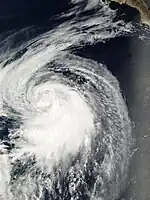  | |
| Duration | September 4 – September 8 |
|---|---|
| Peak intensity | 65 mph (100 km/h) (1-min); 994 mbar (hPa) |
A tropical wave crossed over Central America between August 28 and August 29. While south of Acapulco, it began showing signs of development. Visible satellite images early on September 4 revealed a partially exposed, but well defined low-level circulation. While deep convection was confined to the southwestern half of the circulation, the convection was close enough to the center for the system to be classified as Tropical Depression Nine-E on September 4, about 300 mi (480 km) west-southwest of Manzanillo, Mexico. Early on September 5, as the depression headed westward, the separation between the circulation center and the deep convection decreased. Several hours later, the depression intensified into Tropical Storm Henriette. The cyclone slowly became better organized on September 6, with the convective pattern becoming more symmetric, while the intensity increase to 60 mph (97 km/h).[42] Henriette turned to the northwest and accelerated somewhat as it began to feel the influence of Hurricane Gil, then located only about 285 mi (459 km) to the southwest. Upper-level easterly flow, which was still evident over the cyclone early on September 6, lessened and a more favorable outflow pattern began to develop. Convective banding near the center became better defined, and Henriette reached its peak intensity of 65 mph (105 km/h) on September 7. The cyclone began weakening due to cold waters and its proximity to Gil. A Fujiwhara interaction between Henriette and Gil occurred on September 8. Henriette soon dissipated after losing its closed low-level circulation. Its remnants were absorbed by Gil.[42]
Tropical Storm Ivo
| Tropical storm (SSHWS) | |
  | |
| Duration | September 10 – September 14 |
|---|---|
| Peak intensity | 50 mph (85 km/h) (1-min); 997 mbar (hPa) |
Ivo formed from a large tropical wave that moved off the African coast on August 26. The wave was accompanied by a large cyclonic rotation at the low to middle levels and numerous thunderstorms when it entered the eastern Atlantic. On August 28, the wave spawned a northward-moving vortex in the eastern Atlantic, but the wave's southern portion continued westward with very limited convective activity. Once the wave reached the western Caribbean Sea on September 5, the shower activity increased and the whole system continued slowly westward over Central America. The cloud pattern gradually became better organized and by September 9, satellite images showed a low to middle-level circulation centered near Acapulco, Mexico. The next day, a portion of the system moved over water and it became a tropical depression about 118 mi (190 km) south-southwest of Acapulco on September 10.[43]
The center of the depression moved slowly west and west-northwestward with its circulation hugging the southwest coast of Mexico. There was moderate easterly shear over the depression as indicated by the location of the convection to the west of the center. Satellite images and a report from a ship indicated that the depression reached tropical storm status by 06:00 UTC September 11. Thereafter, there was only slight strengthening and Ivo reached its maximum intensity of 50 mph (80 km/h) and an estimated minimum pressure of 997 mbar (hPa; 29.44 inHg) on September 12. The tropical storm moved toward the northwest and then west over increasingly cooler waters, and gradually weakened. It became a low-pressure system devoid of convection by the end of September 14.[43]
Tropical Depression One-C
| Tropical depression (SSHWS) | |
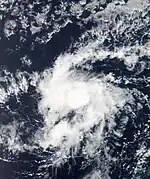  | |
| Duration | September 11 – September 11 |
|---|---|
| Peak intensity | 35 mph (55 km/h) (1-min); 1005 mbar (hPa) |
Tropical Depression One-C formed on September 11 more than 400 mi (640 km) southeast of the Big Island of Hawaii. The system moved west-northwestward to 15°N 153°W initially, and then shifted southwestward shortly thereafter. A poorly organized system, the convection of Tropical Depression One-C dissipated later on September 11, after having been a depression for only 12 hours.[44]
Hurricane Juliette
| Category 4 hurricane (SSHWS) | |
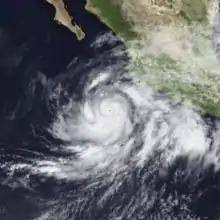 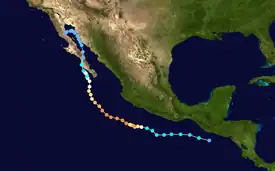 | |
| Duration | September 21 – October 3 |
|---|---|
| Peak intensity | 145 mph (230 km/h) (1-min); 923 mbar (hPa) |
An area of disturbed weather associated with the remnants of Atlantic Tropical Depression Nine organized directly into Tropical Storm Juliette in the East Pacific on September 21. Moving generally northwestward under the influence of a mid-level ridge to the north, Juliette strengthened, aided by a low wind shear environment. It became a hurricane the next day, and rapidly intensified to a Category 4 hurricane on September 23. A pinhole eye appeared on the 24th, and Juliette reached peak intensity on September 25 with 145 mph (233 km/h) winds and a minimum barometric pressure of 923 millibars. Juliette developed rare concentric eyewalls as it reached peak intensity, which persisted from September 24 to the 27th. On September 26, Juliette turned northward around a strong trough over the western United States and began to weaken. Passing just west of Cabo San Lucas on September 28 with 90 mph (140 km/h) winds, it made landfall near San Carlos as a minimal tropical storm two days later. Juliette crossed the Baja California Peninsula into Gulf of California as a tropical depression and dissipated over the far northern part of the gulf on October 3.[45]
Juliette dumped heavy rains on the Baja California Peninsula and in Sonora, where it caused two deaths. Its effects were especially hard on Cabo San Lucas, Baja California Sur, which was cut off from the outside world for a few days. The remnants of Juliette moved into the state of California, where they caused thunderstorms, rain, and some downed power lines.[45] The total estimated cost of damage was $400 million (2001 USD; $661 million 2023 USD).[46]
Hurricane Kiko
| Category 1 hurricane (SSHWS) | |
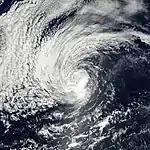  | |
| Duration | September 21 – September 25 |
|---|---|
| Peak intensity | 75 mph (120 km/h) (1-min); 990 mbar (hPa) |
A tropical wave that led to the formation of Atlantic Hurricane Felix over the eastern Atlantic on September 7 also seems to have produced Kiko. This wave moved westward at low latitudes, crossing northern South America and Central America into the East Pacific from September 13 to 16. By September 17, cloudiness and showers increased near the Gulf of Tehuantepec. The area of disturbed weather moved westward for the next few days, without much increase in organization. On September 21, the system's cloud pattern became more consolidated, and curved bands of showers were evident. It is estimated that Tropical Depression Twelve-E had formed that day, at which time it was centered about 634 mi (1,020 km) southwest of the southern tip of Baja California.[47] Located in an environment of easterly vertical shear, the system strengthened slowly. By September 22 the organization of the cloud pattern improved, and the cyclone strengthened into Tropical Storm Kiko. Kiko turned from a northwestward to a west-northwestward heading that day. Although some easterly shear continued to affect the system, very deep convection persisted near the center, and based on Dvorak intensity estimates, Kiko strengthened into a hurricane around September 23. A little later on September 23, deep convection decreased in coverage and intensity and Hurricane Kiko weakened back to a tropical storm.[47] The system continued to fall in intensity on September 24, in part due to the entrainment of more stable air into the circulation. Kiko weakened to a tropical depression on September 25, by which time southwesterly shear also became prevalent. The cyclone degenerated into a westward-moving swirl of low clouds with little or no deep convection later that day. Kiko's remnant low persisted and continued moving generally westward for several more days with intermittent, minor occurrences of deep convection within the circulation. It was finally absorbed into a frontal system to the northeast of the Hawaiian Islands on October 1.[47]
Tropical Storm Two-C
| Tropical storm (SSHWS) | |
  | |
| Duration | September 23 – September 25 |
|---|---|
| Peak intensity | 40 mph (65 km/h) (1-min); 1008 mbar (hPa) |
Tropical Storm Two-C formed near 10°N 147.4°W on September 22, southwest of Tropical Storm Kiko (in the East Pacific). Throughout September 23, Tropical Depression Two-C remained a poorly organized system that slowly moved west-northwestward. A slight increase in convection became apparent on September 24, and was followed by a period of consistent thunderstorm activity near the circulation center as the depression continued in the west-northwest direction. The system dissipated during September 25, after it had peaked with 1-minute sustained windspeeds of 35 kn (65 km/h; 40 mph).[44][6]
Tropical Storm Lorena
| Tropical storm (SSHWS) | |
  | |
| Duration | October 2 – October 4 |
|---|---|
| Peak intensity | 60 mph (95 km/h) (1-min); 997 mbar (hPa) |
The tropical wave that eventually developed into Lorena moved off the west coast of Africa on September 13. The poorly defined wave tracked rapidly westward across the Atlantic for more than a week. There was little or no thunderstorm activity associated with the wave until it moved across Central America on September 27. Significant deep convection finally developed on September 29 and satellite classifications began on September 30 when the system was located about 300 mi (480 km) south of Acapulco, Mexico. The wave possessed a well-defined closed low-level circulation at that time.[48] Convection steadily increased and banding features developed during the day on October 1. Satellite intensity estimates indicate the system became Tropical Depression Thirteen-E at October 2. Low-level circulation had tightened up considerably and satellite intensity estimates indicated the depression had strengthened into Tropical Storm Lorena about 350 mi (560 km) south-southwest of Acapulco. Lorena reached its peak intensity 60 mph (97 km/h) later that day as it took a more northerly track when it was located about 205 mi (330 km) southwest of Manzanillo, Mexico.[48] By October 4, the forward speed of Tropical Storm Lorena had decreased to around seven to nine mph (11 to 14 km/h) and strong upper-level southwesterly shear began to adversely affect the cyclone. Lorena weakened to a tropical depression and dissipated into a non-convective low later that day about 120 mi (190 km) southwest of Puerto Vallarta, Mexico. The remnant low-level cloud circulation remained offshore and persisted for another day or so before completely dissipating just west of Cabo Corrientes, Mexico.[48]
Tropical Depression Fourteen-E
| Tropical depression (SSHWS) | |
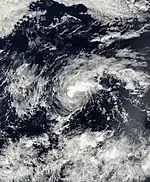  | |
| Duration | October 3 – October 4 |
|---|---|
| Peak intensity | 35 mph (55 km/h) (1-min); 1008 mbar (hPa) |
Tropical Depression Fourteen-E developed from a small swirl of low clouds that was first observed along the Intertropical Convergence Zone well to the south-southwest of Baja California on September 30. Little development occurred until October 3, when the system began to generate more persistent deep convection.[49] While the system was located about 800 mi (1,300 km) southwest of the southern tip of Baja California, the NHC began to classify it as Tropical Depression Fourteen-E. Although it appeared that wind shear was at initially predicted to remain at a favorable level,[50] an upper-level low to the southwest of the depression generated wind shear greater than expected, and convection significantly weakened only hours later. Despite significant effects from wind shear, the depression was still forecast to intensify into a tropical storm.[51] Later that day, the low-level center of the depression became more difficult to locate on satellite images, and the location of the poorly defined center was estimated.[52] Convection significantly decreased again early on October 4,[53] and the depression dissipated 900 mi (1,400 km) southwest of the southern tip of Baja California. The remnant low cloud swirl continued westward for another 24–36 hours before dissipating completely.[49]
Tropical Storm Manuel
| Tropical storm (SSHWS) | |
  | |
| Duration | October 10 – October 18 |
|---|---|
| Peak intensity | 60 mph (95 km/h) (1-min); 997 mbar (hPa) |
Tropical Storm Manuel formed from the remnants of Hurricane Iris from the Atlantic Basin. The core circulation of Iris had dissipated over the mountains of eastern Mexico, while new convection was developing a short distance away over the waters of the Pacific. This area became better organized over the next 18 hours and became Tropical Depression Fifteen-E at October 10, about 175 mi (282 km) south-southeast of Acapulco, Mexico. The depression moved at 15–16 mph (24–26 km/h), first westward and then west-northwestward. An upper-level anticyclone centered over southern Mexico was producing some easterly shear in the environment of the depression, but when this shear lessened the system became Tropical Storm Manuel on October 11, about 200 mi (320 km) south-southwest of Zihuatanejo, Mexico. An estimated initial peak intensity of 50 mph (80 km/h) was reached that day when the first clear banding features developed. However, the banding was short-lived, deep convection diminished, and satellite microwave imagery early on October 12 suggested that the circulation was becoming elongated. Wind shear returned, this time from the northwest, and Manuel turned to a west-southwesterly track and slowed. By October 12, Manuel had weakened to a tropical depression.[54]
Manuel remained a disorganized depression for the next two and a half days. It continued moving to the west-southwest, but slowed to a drift as a mid-level ridge to the north of the cyclone gradually weakened. An upper-level trough dug southward to the west of Manuel early on October 15, and Manuel began to move to the north-northwest. Convection redeveloped near the center and Manuel regained tropical storm strength on October 15 about 596 mi (959 km) south-southwest of Cabo San Lucas, Mexico. Wind shear decreased and Manuel strengthened, reaching its peak intensity of 60 mph (97 km/h) winds, and a pressure of 997 mbar (hPa; 29.44 inHg) on October 16 about 540 mi (870 km) southwest of Cabo San Lucas. By this point, water temperatures under the cyclone were decreasing and shear, this time from the southwest, was increasing. Manuel began to weaken while moving to the west-northwest and northwest. It became a depression at October 17 about 660 mi (1,060 km) west-southwest of Cabo San Lucas, and dissipated to a non-convective low shortly after October 18. The remnant low moved slowly westward for a couple of days over cool waters before its circulation dissipated completely.[54]
Hurricane Narda
| Category 1 hurricane (SSHWS) | |
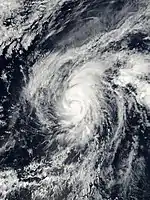  | |
| Duration | October 20 – October 25 |
|---|---|
| Peak intensity | 85 mph (140 km/h) (1-min); 980 mbar (hPa) |
Narda developed from a westward moving tropical wave that crossed Dakar, Senegal around the October 3. The wave became convectively active after it crossed Central America when it produced a large burst of convection in the Bay of Campeche on the October 15. The southern portion of the wave continued westward over the Pacific waters south of Mexico and under favorable upper-level winds, it began to acquire banding features and several centers of circulation. The system finally consolidated and developed one center at October 20. It became a tropical depression about 1,150 mi (1,850 km) southwest of Cabo San Lucas, Mexico. Moving on a west-northwest track, it intensified and reached tropical storm status later that day. The cloud pattern continued to become better organized and visible satellite imagery showed an intermittent eye feature, and it is estimated that Narda became a hurricane at October 21. Narda peak's intensity of 980 mbar (hPa; 28.94 inHg) occurred on October 22. Thereafter, a gradual weakening began and strong shear took a toll on Narda. The tropical cyclone became a tight swirl of low clouds with intermittent convection on October 24, as it moved westward steered by the low-level flow and crossing 140°W over the Central Pacific area of responsibility. It then continued westward as a tropical depression until dissipation.[55]
Hurricane Octave
| Category 1 hurricane (SSHWS) | |
  | |
| Duration | October 31 – November 3 |
|---|---|
| Peak intensity | 85 mph (140 km/h) (1-min); 980 mbar (hPa) |
The final tropical depression of the season likely developed from a weak tropical wave that moved westward across Central America on October 22. Following an area in convection on October 27 and the formation of a low-level circulation, the system was declared a tropical depression at 00:00 UTC on October 31, while centered about 1,180 mi (1,900 km) southwest of the southern tip of Baja California.[56] The depression was initially affected by easterly upper-level winds and outflow was restricted on the eastern quadrant.[57] The depression intensified and was upgraded to Tropical Storm Octave six hours after forming.[58] Although cloud tops warmed on October 31, Octave organized further,[59] and the NHC noted that the storm began to resemble a hurricane early on November 1.[60] Shortly thereafter, no significant intensification was predicted, as the cloud pattern was becoming elongated, vertical wind shear would soon increase, and Octave would soon entering a region of decreasing sea surface temperatures.[61] However, Octave re-organized and an eye feature began developing later on November 1.[62]
The storm was upgraded to a hurricane after a ragged eye developed and T-numbers reached 4.0 on the Dvorak Scale.[63] Early on November 2, Octave attained its peak intensity with maximum sustained winds of 85 mph (137 km/h) and a minimum barometric pressure of 980 mbar (hPa; 28.94 inHg).[56] Wind shear began to increase, while sea surface temperatures were decreasing, causing the low-level circulation to become gradually displaced from the associated deep convection.[64] However, the storm remained a hurricane until 18:00 UTC on November 2.[56] By early on November 3, only minimal deep convection was associated with Octave.[65] The NHC downgraded the system to a tropical depression later that day.[66] Deep convection associated with Octave remained minimal, and the system had degenerated into a remnant low located about 1,715 mi (2,760 km) west-southwest of the southern tip of Baja California at 00:00 UTC on November 4.[56]
Storm names
The following names were used for named storms that formed in the northeast Pacific in 2001. The names not retired from this list were used again in the 2007 Pacific hurricane season. This is the same list used for the 1995 season except for Ivo, which replaced Ismael. A storm was named Ivo for the first time in 2001. Names that were not assigned are marked in gray.
|
|
|
For storms that form in the Central Pacific Hurricane Center's area of responsibility, encompassing the area between 140 degrees west and the International Date Line, all names are used in a series of four rotating lists. The next four names that were slated for use in 2001 are shown below, however none of them were used.
|
|
|
|
Retirement
After the season had begun the names Adolph and Israel (the original replacement for Ismael) were retired for political considerations, after a row brewed over the use of their names. They were replaced with Alvin and Ivo for the 2007 season, though the latter was used for the first time during this season.[67][68][69]
Season effects
This is a table of all the storms that formed in the 2001 Pacific hurricane season. It includes their duration, names, intensities, areas affected, damages, and death totals. Deaths in parentheses are additional and indirect (an example of an indirect death would be a traffic accident), but were still related to that storm. Damage and deaths include totals while the storm was extratropical, a wave, or a low, and all the damage figures are in 2001 USD.
| Saffir–Simpson scale | ||||||
| TD | TS | C1 | C2 | C3 | C4 | C5 |
| Storm name |
Dates active | Storm category at peak intensity |
Max 1-min wind mph (km/h) |
Min. press. (mbar) |
Areas affected | Damage (USD) |
Deaths | Ref(s) | ||
|---|---|---|---|---|---|---|---|---|---|---|
| Adolph | May 25 – June 1 | Category 4 hurricane | 145 (230) | 940 | None | None | None | |||
| Barbara | June 20 – 26 | Tropical storm | 60 (95) | 997 | Hawaiian Islands | None | None | |||
| Cosme | July 13 – 15 | Tropical storm | 45 (75) | 1000 | Baja California Peninsula | None | None | |||
| Erick | July 20 – 24 | Tropical storm | 40 (65) | 1001 | None | None | None | |||
| Dalila | July 21 – 28 | Category 1 hurricane | 75 (120) | 982 | Southwestern Mexico, Baja California Peninsula | $1 million | 1 | |||
| Six-E | August 22 – 24 | Tropical depression | 35 (55) | 1006 | None | None | None | |||
| Flossie | August 26 – September 2 | Category 2 hurricane | 105 (165) | 972 | Northwestern Mexico | $35,000 | 2 | |||
| Gil | September 4 – 11 | Category 2 hurricane | 100 (155) | 974 | None | None | None | |||
| Henriette | September 4 – 8 | Tropical storm | 65 (100) | 994 | None | None | None | |||
| Ivo | September 10 – 14 | Tropical storm | 50 (85) | 997 | Southwestern Mexico, Baja California Peninsula | None | None | |||
| One-C | September 11 | Tropical depression | 35 (55) | 1001 | None | None | None | |||
| Juliette | September 21 – October 3 | Category 4 hurricane | 145 (230) | 923 | Baja California Peninsula, Northwestern Mexico, Southwern Mexico, California, Arizona | $401 million | 13 | |||
| Kiko | September 21 – 25 | Category 1 hurricane | 75 (120) | 989 | None | None | None | |||
| Unnamed | September 23 – 25 | Tropical storm | 40 (65) | 1008 | None | None | None | |||
| Lorena | October 2 – 4 | Tropical storm | 65 (100) | 996 | Southwestern Mexico | Minimal | None | |||
| Fourteen-E | October 3 – 4 | Tropical depression | 35 (55) | 1007 | None | None | None | |||
| Manuel | October 10 – 18 | Tropical storm | 60 (95) | 997 | None | None | None | |||
| Narda | October 20 – 25 | Category 1 hurricane | 85 (140) | 979 | None | None | None | |||
| Octave | October 31 – November 3 | Category 1 hurricane | 85 (140) | 980 | None | None | None | |||
| Season aggregates | ||||||||||
| 19 systems | May 25 – November 3 | 145 (230) | 923 | $402 million | 16 | |||||
See also
- Tropical cyclones in 2001
- List of Pacific hurricanes
- Pacific hurricane season
- 2001 Atlantic hurricane season
- 2001 Pacific typhoon season
- 2001 North Indian Ocean cyclone season
- South-West Indian Ocean cyclone seasons: 2000–01, 2001–02
- Australian region cyclone seasons: 2000–01, 2001–02
- South Pacific cyclone seasons: 2000–01, 2001–02
References
- Neal Dorst (June 2, 2016). "TCFAQ G1) When is hurricane season?". Atlantic Oceanographic and Meteorological Laboratory. Archived from the original on May 6, 2009. Retrieved July 24, 2018.
- Avila, Lixion A.; Pasch, Richard J.; Beven, Jack L.; Franklin, James L.; Lawrence, Miles B.; Stewart, Stacy R.; Jiing, Jiann-Gwo (January 2003). "Eastern North Pacific Hurricane Season of 2001". Monthly Weather Review. 131 (1): 249–262. Bibcode:2003MWRv..131..249A. doi:10.1175/1520-0493(2003)131<0249:ASNPHS>2.0.CO;2.
- Hurricane Specialist Unit (December 1, 2001). Monthly Tropical Weather Summary: November (Report). National Hurricane Center. Retrieved April 28, 2017.
- Hurricane Specialist Unit (August 1, 2001). Monthly Tropical Weather Summary: July (Report). National Hurricane Center. Retrieved April 28, 2017.
- Hurricane Specialist Unit (September 1, 2001). Monthly Tropical Weather Summary: August (Report). National Hurricane Center. Retrieved April 28, 2017.
- National Hurricane Center; Hurricane Research Division; Central Pacific Hurricane Center (April 4, 2023). "The Northeast and North Central Pacific hurricane database 1949–2022". United States National Oceanic and Atmospheric Administration's National Weather Service. A guide on how to read the database is available here.
 This article incorporates text from this source, which is in the public domain.
This article incorporates text from this source, which is in the public domain. - Blake, Eric S; Gibney, Ethan J; Brown, Daniel P; Mainelli, Michelle; Franklin, James L; Kimberlain, Todd B; Hammer, Gregory R (2009). Tropical Cyclones of the Eastern North Pacific Basin, 1949-2006 (PDF). Archived from the original on July 28, 2013. Retrieved June 14, 2013.
- Stewart, Stacy (June 18, 2001). "Hurricane Adolph Tropical Cyclone Report". National Hurricane Center. Retrieved November 30, 2010.
- Beven, Jack (August 7, 2001). "Tropical Storm Barbara Tropical Cyclone Report". National Hurricane Center. Retrieved November 30, 2010.
- Avila, Lixion (June 20, 2001). "Tropical Depression Two-E Discussion #2". National Hurricane Center. Retrieved December 4, 2010.
- Franklin, James (June 20, 2001). "Tropical Storm Barbara Discussion #4". National Hurricane Center. Retrieved December 4, 2010.
- Avila, Lixion (June 21, 2001). "Tropical Storm Barbara Discussion #6". National Hurricane Center. Retrieved December 4, 2010.
- Kelly, Robert; Loos, Treena; Kodama, Kevin (February 2002). 2001 Tropical Cyclones Central North Pacific (PDF) (Report). Central Pacific Hurricane Center. Retrieved June 9, 2019.
- Franklin, James (July 18, 2001). "Tropical Storm Cosme Tropical Cyclone Report". National Hurricane Center. Retrieved November 14, 2010.
- Avila, Lixion (July 31, 2001). "Tropical Storm Erick Tropical Cyclone Report". National Hurricane Center. Retrieved November 25, 2010.
- Lawrence, Miles (August 13, 2001). "Hurricane Dalila Tropical Cyclone Report" (PDF). National Hurricane Center. Retrieved November 25, 2010.
- Pasch, Richard (October 25, 2001). "Tropical Depression Six-E Tropical Cyclone Report" (PDF). National Hurricane Center. Retrieved February 29, 2016.
- Avila, Lixion; Pasch, Richard (August 22, 2001). "Tropical Depression Six-E Discussion #1". National Hurricane Center. Retrieved December 21, 2010.
- Cobb, Hugh; Franklin, James (August 23, 2001). "Tropical Depression Six-E Discussion #2". National Hurricane Center. Retrieved December 21, 2010.
- Stewart, Stacy (August 23, 2001). "Tropical Depression Six-E Discussion #3". National Hurricane Center. Retrieved December 21, 2010.
- Avila, Lixion (August 23, 2001). "Tropical Depression Six-E Discussion #4". National Hurricane Center. Retrieved December 21, 2010.
- Cobb, Hugh; Franklin, James (August 23, 2001). "Tropical Depression Six-E Discussion #6". National Hurricane Center. Retrieved December 21, 2010.
- Stewart, Stacy (October 27, 2001). "Hurricane Flossie Tropical Cyclone Report" (PDF). National Hurricane Center. Retrieved February 29, 2016.
- Pasch, Richard (August 26, 2001). "Tropical Depression Seven-E Discussion #1". National Hurricane Center. Retrieved January 28, 2011.
- Stewart, Stacy (August 26, 2001). "Tropical Storm Flossie Discussion #3". National Hurricane Center. Retrieved January 28, 2011.
- Stewart, Stacy (August 27, 2001). "Hurricane Flossie Discussion #7". National Hurricane Center. Retrieved February 4, 2011.
- Beven, Jack (August 29, 2001). "Hurricane Flossie Discussion #13". National Hurricane Center. Retrieved February 4, 2011.
- Stewart, Stacy (August 29, 2001). "Hurricane Flossie Discussion #14". National Hurricane Center. Retrieved February 4, 2011.
- Stewart, Stacy (August 29, 2001). "Hurricane Flossie Discussion #15". National Hurricane Center. Retrieved February 4, 2011.
- Pasch, Richard; Rhome, Jamie (August 29, 2001). "Hurricane Flossie Discussion #19". National Hurricane Center. Retrieved February 4, 2011.
- Molleda, Robert; Avila, Lixion (August 30, 2001). "Tropical Storm Flossie Discussion #20". National Hurricane Center. Retrieved February 4, 2011.
- Lawrence, Miles (September 1, 2001). "Tropical Depression Flossie Discussion #26". National Hurricane Center. Retrieved February 4, 2011.
- Lawrence, Miles (September 1, 2001). "Tropical Depression Flossie Discussion #27". National Hurricane Center. Retrieved February 4, 2011.
- Jarvinen, Brian (September 2, 2001). "Tropical Depression Flossie Discussion #28". National Hurricane Center. Retrieved February 4, 2011.
- Beven, Jack (October 25, 2001). "Hurricane Gil Tropical Cyclone Report" (PDF). National Hurricane Center. Retrieved March 1, 2016.
- Beven, Jack; Molleda, Robert (September 5, 2001). "Tropical Storm Gil Discussion #5". National Hurricane Center. Retrieved December 21, 2010.
- Franklin, James (September 5, 2001). "Tropical Storm Gil Discussion #7". National Hurricane Center. Retrieved December 21, 2010.
- Pasch, Richard; Aguirre-Echevarria, Jorge (September 6, 2001). "Hurricane Gil Discussion #8". National Hurricane Center. Retrieved December 21, 2010.
- Franklin, James (September 7, 2001). "Hurricane Gil Discussion #15". National Hurricane Center. Retrieved December 21, 2010.
- Franklin, James (September 8, 2001). "Hurricane Gil Discussion #19". National Hurricane Center. Retrieved December 21, 2010.
- Beven, Jack (September 9, 2001). "Hurricane Gil Discussion #21". National Hurricane Center. Retrieved December 21, 2010.
- Brown, Daniel; Franklin, James (September 24, 2001). "Tropical Storm Henriette Tropical Cyclone Report". National Hurricane Center. Retrieved November 30, 2010.
- Avila, Lixion (October 23, 2001). "Tropical Storm Ivo Tropical Cyclone Report". National Hurricane Center. Retrieved November 30, 2010.
- Kelly, Robert; Loos, Treena; Kodama, Kevin (2001). "2001 Tropical Cyclones Central North Pacific". Central Pacific Hurricane Center. Retrieved November 26, 2010.
- Lawrence, Miles; Mainelli, Michelle (November 30, 2001). "Hurricane Juliette Tropical Cyclone Report". National Hurricane Center. Retrieved December 1, 2010.
- "Search Details Disaster List". Centre for Research on the Epidemiology of Disasters. 2009. Archived from the original on September 23, 2010. Retrieved December 1, 2010.
- Pasch, Richard (December 18, 2001). "Hurricane Kiko Tropical Cyclone Report" (PDF). National Hurricane Center. Retrieved November 26, 2010.
- Stewart, Stacy (November 30, 2001). "Tropical Storm Lorena Tropical Cyclone Report". National Hurricane Center. Retrieved November 25, 2010.
- Beven, Jack (October 24, 2001). "Tropical Depression Fourteen-E Tropical Cyclone Report" (PDF). National Hurricane Center. Retrieved March 1, 2016.
- Beven, Jack (October 3, 2001). "Tropical Depression Fourteen-E Discussion #1". National Hurricane Center. Retrieved January 26, 2011.
- Pasch, Richard; Molleda, Robert (October 3, 2001). "Tropical Depression Fourteen-E Discussion #2". National Hurricane Center. Retrieved January 26, 2011.
- Pasch, Richard; Molleda, Robert (October 3, 2001). "Tropical Depression Fourteen-E Discussion #3". National Hurricane Center. Retrieved January 27, 2011.
- Franklin, James; Knabb, Rick; Aguirre-Echevarria, Jorge (October 4, 2001). "Tropical Depression Fourteen-E Discussion #4". National Hurricane Center. Retrieved January 27, 2011.
- Franklin, James (October 31, 2001). "Tropical Storm Manuel Tropical Cyclone Report". National Hurricane Center. Archived from the original on October 18, 2010. Retrieved November 25, 2010.
- Avila, Lixion (November 13, 2001). "Hurricane Narda Tropical Cyclone Report" (PDF). National Hurricane Center. Retrieved November 14, 2010.
- Lawrence, Miles (December 6, 2001). "Hurricane Octave Tropical Cyclone Report" (PDF). National Hurricane Center. Retrieved March 1, 2016.
- Stewart, Stacy (October 31, 2001). "Tropical Depression Seventeen-E Discussion #1". National Hurricane Center. Retrieved December 2, 2010.
- Pasch, Richard (October 31, 2001). "Tropical Storm Octave Discussion #2". National Hurricane Center. Retrieved December 2, 2010.
- Beven, Jack (October 31, 2001). "Tropical Storm Octave Discussion #4". National Hurricane Center. Retrieved December 2, 2010.
- Stewart, Stacy (November 1, 2001). "Tropical Storm Octave Discussion #5". National Hurricane Center. Retrieved December 2, 2010.
- Pasch, Richard (November 1, 2001). "Tropical Storm Octave Discussion #6". National Hurricane Center. Retrieved December 2, 2010.
- Avila, Lixion (November 1, 2001). "Tropical Storm Octave Discussion #7". National Hurricane Center. Retrieved December 2, 2010.
- Pasch, Richard (November 1, 2001). "Hurricane Octave Discussion #8". National Hurricane Center. Retrieved December 3, 2010.
- Pasch, Richard (November 2, 2001). "Hurricane Octave Discussion #11". National Hurricane Center. Retrieved December 3, 2010.
- Cobb, Hugh; Avila, Lixion (November 3, 2001). "Tropical Storm Octave Discussion #13". National Hurricane Center. Retrieved December 3, 2010.
- Jarviven, Brian (November 3, 2001). "Tropical Depression Octave Discussion #15". National Hurricane Center. Retrieved December 3, 2010.
- Wohlhelernter, Elli (May 21, 2001). "Storm brewing over hurricane named Israel". The Jerusalem Post. Archived from the original on June 11, 2014. Retrieved July 21, 2012. (Accessed through the HighBeam Research archives.)
- "Storm blows over as 'Hurricane Israel' is retired". The Jerusalem Post. June 6, 2001. Archived from the original on June 11, 2014. Retrieved July 21, 2012. (Accessed through the HighBeam Research News archives.)
- Padgett Gary; Beven, John (Jack) L; Lewis Free, James; Delgado, Sandy; The Atlantic Oceanographic and Meteorological Laboratory's Hurricane Research Division (June 1, 2012). "Subject: B3) What storm names have been retired?". Tropical Cyclone Frequently Asked Questions. National Oceanic and Atmospheric Administration's Oceanic and Atmospherc Research office. Retrieved December 8, 2006.
External links
- National Hurricane Center Website
- National Hurricane Center's Eastern Pacific Tropical Weather Outlook
- Servicio Meteorológico Nacional Website (in Spanish)
- Joint Typhoon Warning Center Archived February 2, 2018, at the Wayback Machine
- NHC 2001 Pacific hurricane season archive
- HPC 2001 Tropical Cyclone Rainfall Pages
- Central Pacific Hurricane Center Archived September 23, 2011, at the Wayback Machine
- Gary Padgett's monthly storm summaries and best tracks